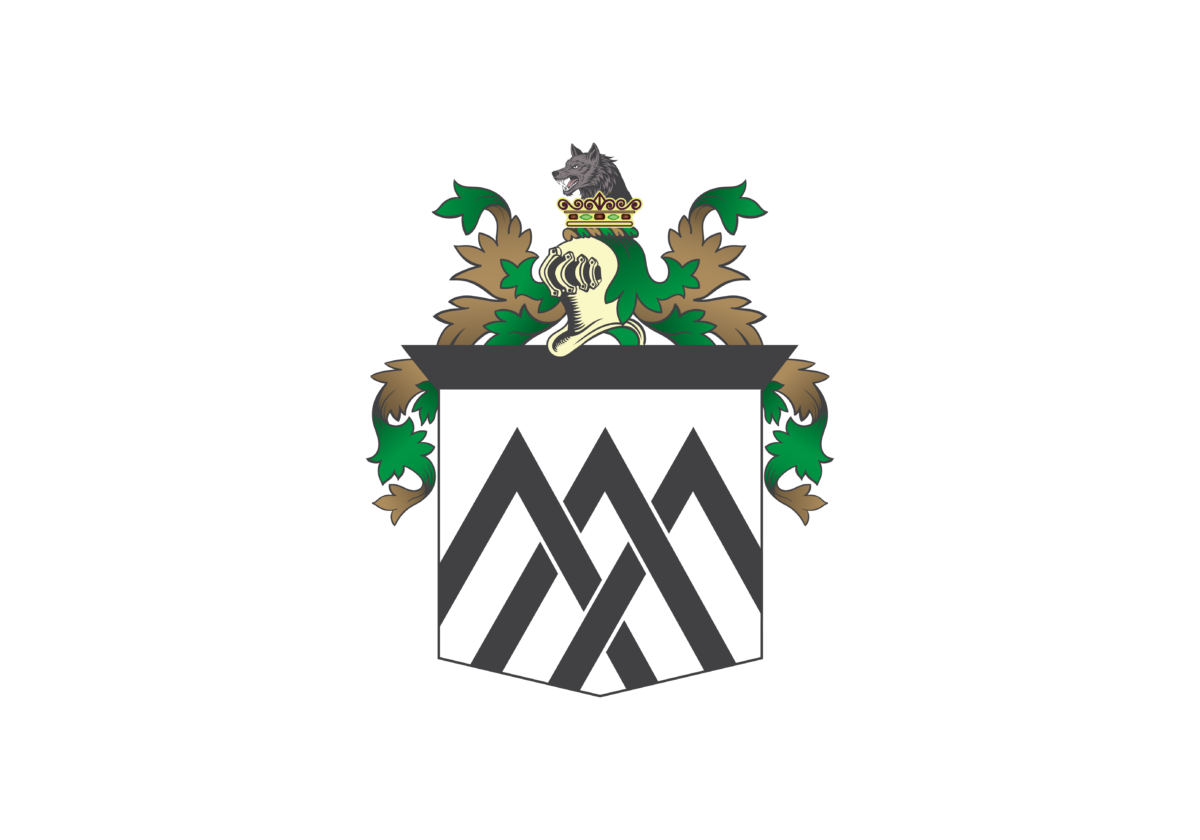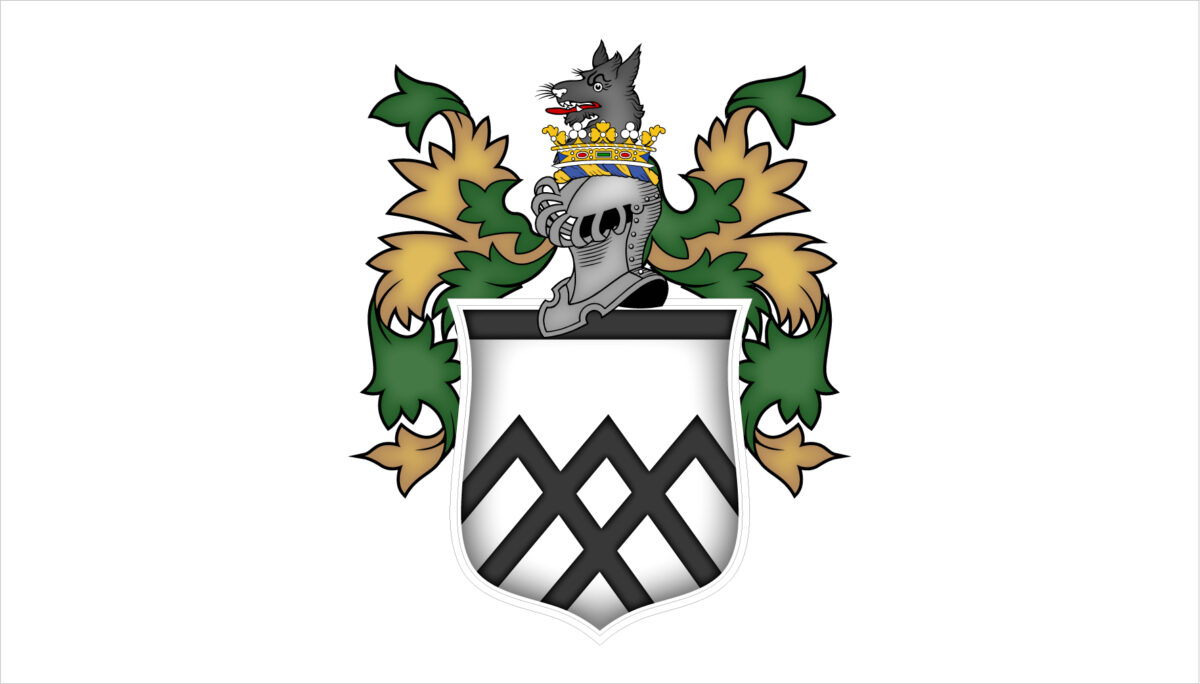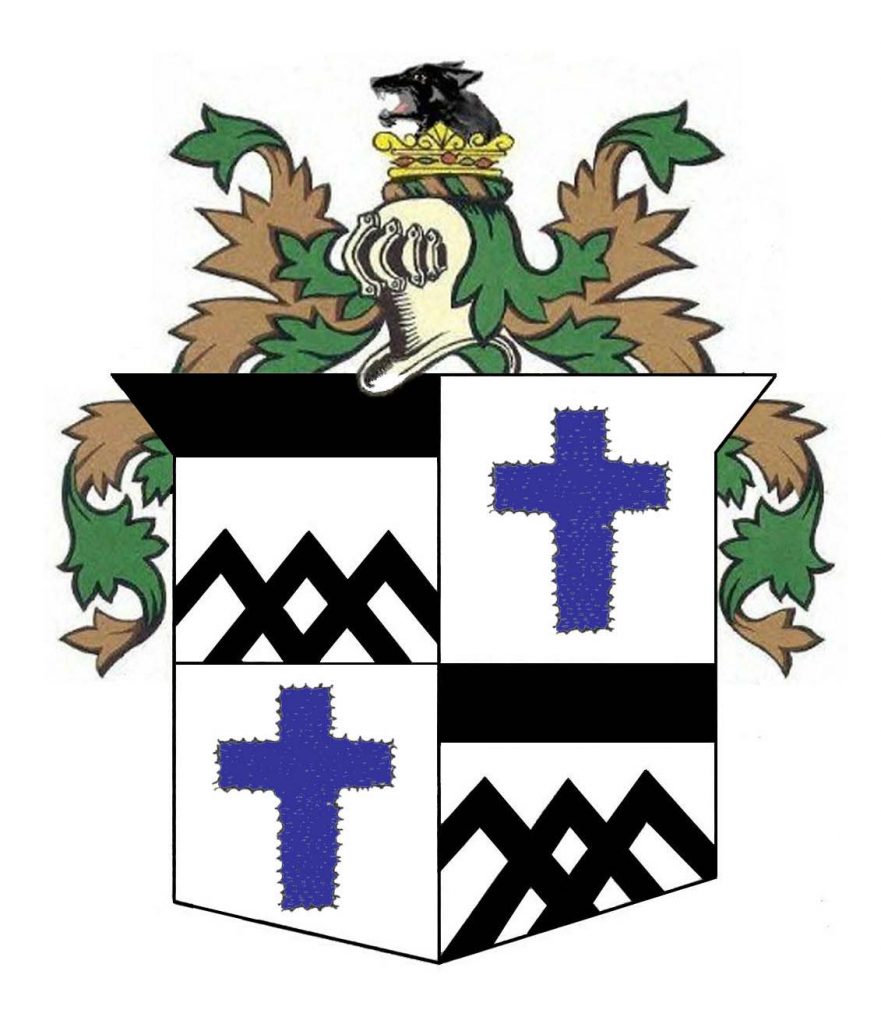


Heraldry formally began in England as a system to identify individuals whose faces were obscured by armor and to distinguish their supporters on the battlefield. The earliest coats of arms are simple, often inspired by the cross braces and structural elements of shields. Individuals bore the arms associated with the fiefdom, manor, or family they served or were allied with.
The coat of arms on the left represents the original arms granted around 1584-1585 to the Cliburn family of Cliburn in Westmorland County.1Ewbank Extracts from “Northern Notes and Queries devoted to the Antiquities of Northumberland, Cumberland, Westmorland and Durham” edited by Henry Reginald Leighton 1906-7 published by ME Dodds of Newcastle. [2007 online edition University of California] This is the family from which our ancestor, Joshua Clyburn, descended. These arms were described as “argent, three chevronels interlaced in base and a chief sable,” with a crest featuring a “demi wolf proper, rampant and regardant.” (Click here for descriptions and definitions of these heraldry terms.)
According to English heraldic tradition, only one person, usually the head of the family, could display the original arms at any given time. Other family members used modified versions until they inherited the original arms upon the patriarch’s passing. Modifications were typically slight, involving a color change or the addition of a new “charge” (symbol).
Over time, a new “charge” known as an “engrailed cross” was added to the Cliburn shield, becoming the more common version. The term “engrailed” is linked to “grill,” suggesting protection, and the spikes on an engrailed cross are traditionally seen by Christians as representing the thorns that pierced Christ’s brow. Harriette Pinnell Threlkeld, an early family historian, illustrated this later version with engrailed crosses.
Interestingly, William Claiborne, the Virginia Secretary born around 1600, used the Cliburn coat of arms on his official documents, and this emblem appears on the gravestones of many of his descendants in Virginia. Notable descendants include fashion designer Liz Claiborne and William C.C. Claiborne, Louisiana’s first governor, as well as various political figures in Tennessee and Virginia.
The similarity in name and arms led to speculation that the Cliburn family discussed here might be related to William Claiborne. However, a Virginia genealogist in the 1940s disproved this Westmorland connection, tracing William’s lineage to Thomas Clebourne, a native of Kent, England, who served as mayor, alderman, and justice of the peace in King’s Lynn, Norfolk. Recent DNA studies have further confirmed that William Claiborne is unrelated to the Cliburn family of Westmorland, leaving the origin of his use of the Cliburn arms an enduring mystery.
“To this the motto of the Cliburn (Clibborn) family seems to bear witness. This could not possibly belong to an earlier time, for only late in the days of Edward III [who ruled from 1327 to 1377] did that family assume the name of Cliburn. The motto, interesting I think as a rare example of a medieval English motto, was “Ne lof clibbor ne(na) sceame (neither praise clings nor disgrace/shame), and was handed down with various loppings till in the seventeenth century it came to the unmeaning ‘Clibbor ne sceame.’…The dialect of the deed as might be conjectured from the position of Cumberland – a borderland inhabited by mixed races – shows disintegration of the inflectional endings and of other grammar, as does the motto quoted above (with ‘sceame’ for ‘sceamu’); and one traces in it, in the matrix of the Anglo-Saxon: Gaelic, Cymric and Norse.”
Oswald Barron, FSA
Motto
Mottos are supposed to have originated in the war cries of the ancients and were said to have been painted on the shields of the warriors. The Claybourn family motto in Saxon is “Lofe clibbor na sceame” or “Ne lof clibbor ne(na) sceame”, which means “Neither Praise Nor Shame Adheres.” The motto in Latin is “Confide recti agens”, which means “Have the confidence to do what is right.”
Because the original motto is written in Anglo-Saxon (Old English) instead of Latin, we can surmise that it was probably devised at a time when Old English could still be widely understood, perhaps as early as the 1300s. That the family motto dates back to the dawn of the English language may be an indicator of the rich and ancient roots of the family itself.
In 1903 Oswald Barron, FSA, a Fellow of the Society of Antiquaries of London, wrote in an English publication, The Ancestor: A Quarterly Review of County and Family History, Heraldry and Antiquities, that the Anglo-Saxon language was still understood by the average person as late as the end of the 1300s.2Barron O. The Ancestor: A Quarterly Review of County and Family History, Heraldry and Antiquities. 1903. 7:244-245. To make his point he stated the following:
Puns in mottos alluding to the owner’s name are fairly common. The translation for each word is as follows:
- Ne = adverb “Not, non, neither”
- Lof = noun “Praise, glory, a song of praise, hymn”
- Clibbor = adjective “Sticky, adhesive” (clifian to cleave, adhere)
- Na = adverb “No, not, non, nor”
- Sceamu = noun “The emotion caused by consciousness of unworthiness or of disgrace. In a good sense: modesty, bashfulness; in a bad sense: shame, confusion.”
Piecing them together into the motto, the entire meaning can then be translated as: “Neither Praise Nor Shame Adheres.”
Crest
Simply put, the crest is the emblem above a knight’s helmet, which later extended to the decoration above a coat of arms. Initially, crests served to distinguish commanders on the battlefield, designed to rise high above their heads. Over time, they gained decorative prominence in tournaments, often growing elaborate and grandiose.
In 1917, John Herbert Claiborne wrote: “In a field, to the rear of Cliburn Hall, stand two old oaks, gnarled, twisted, and decaying. Admiral Cleburne told the writer they were the sole remaining giants of the ancient Forest of Englewood. They are of interest, since they suggest the story told by the Admiral touching a tradition about the Cleburne crest. He said, in very ancient times, when the Forest of Englewood was thick and flour-ishing, one of the Lords of the Manor, returning home late one evening, was caught in a thunderstorm in the forest; a thunderbolt struck a tree, and a falling limb nearly knocked him from his horse. At that moment, a wolf ran out of the brush and startled the horse, causing it to shy so that the limb fell short, leaving the rider unharmed. From this incident, the wolf is said to have been adopted as the family crest, where it remains to this day. . . Another tradition claims the wolf came from ‘Hugh Lupus,’ Lord Paramount of Cleburne and other lands, but the incident related furnishes the more interesting explanation.”3Claiborne, John Herbert. “William Claiborne of Virginia With Some Account of His Pedigree.” G.P. Putnam’s Sons New York and London, The Knickerbocker Press 1917 4Note on Hugh Lupus: The ancient Barony of Westmorland was granted by William the Conqueror to Ranulph de Meschines, who married the sister of Hugh Lupus, Earl of Chester. Their son Ranulph granted his estates in Westmorland to his sister, whose descendant Sir Hugh de Morville was involved in the murder of Thomas Becket, Archbishop of Canterbury. Sir Hugh forfeited his estates, which went to his nephew, Robert de Veteripont or Vipont. Ivo de Veteripont, son of William de Veteripont and Maud de Morville – sister of Sir Hugh de Morville – gave the manor of Maud’s Meaburn to John le Franceys, baron exchequer.
Footnotes
- 1Ewbank Extracts from “Northern Notes and Queries devoted to the Antiquities of Northumberland, Cumberland, Westmorland and Durham” edited by Henry Reginald Leighton 1906-7 published by ME Dodds of Newcastle. [2007 online edition University of California]
- 2Barron O. The Ancestor: A Quarterly Review of County and Family History, Heraldry and Antiquities. 1903. 7:244-245.
- 3Claiborne, John Herbert. “William Claiborne of Virginia With Some Account of His Pedigree.” G.P. Putnam’s Sons New York and London, The Knickerbocker Press 1917
- 4Note on Hugh Lupus: The ancient Barony of Westmorland was granted by William the Conqueror to Ranulph de Meschines, who married the sister of Hugh Lupus, Earl of Chester. Their son Ranulph granted his estates in Westmorland to his sister, whose descendant Sir Hugh de Morville was involved in the murder of Thomas Becket, Archbishop of Canterbury. Sir Hugh forfeited his estates, which went to his nephew, Robert de Veteripont or Vipont. Ivo de Veteripont, son of William de Veteripont and Maud de Morville – sister of Sir Hugh de Morville – gave the manor of Maud’s Meaburn to John le Franceys, baron exchequer.

